CHEMIST and DEVELOPER OF LUCOZADE
Situated in the Consecrated/West Section of Jesmond Old Cemetery.
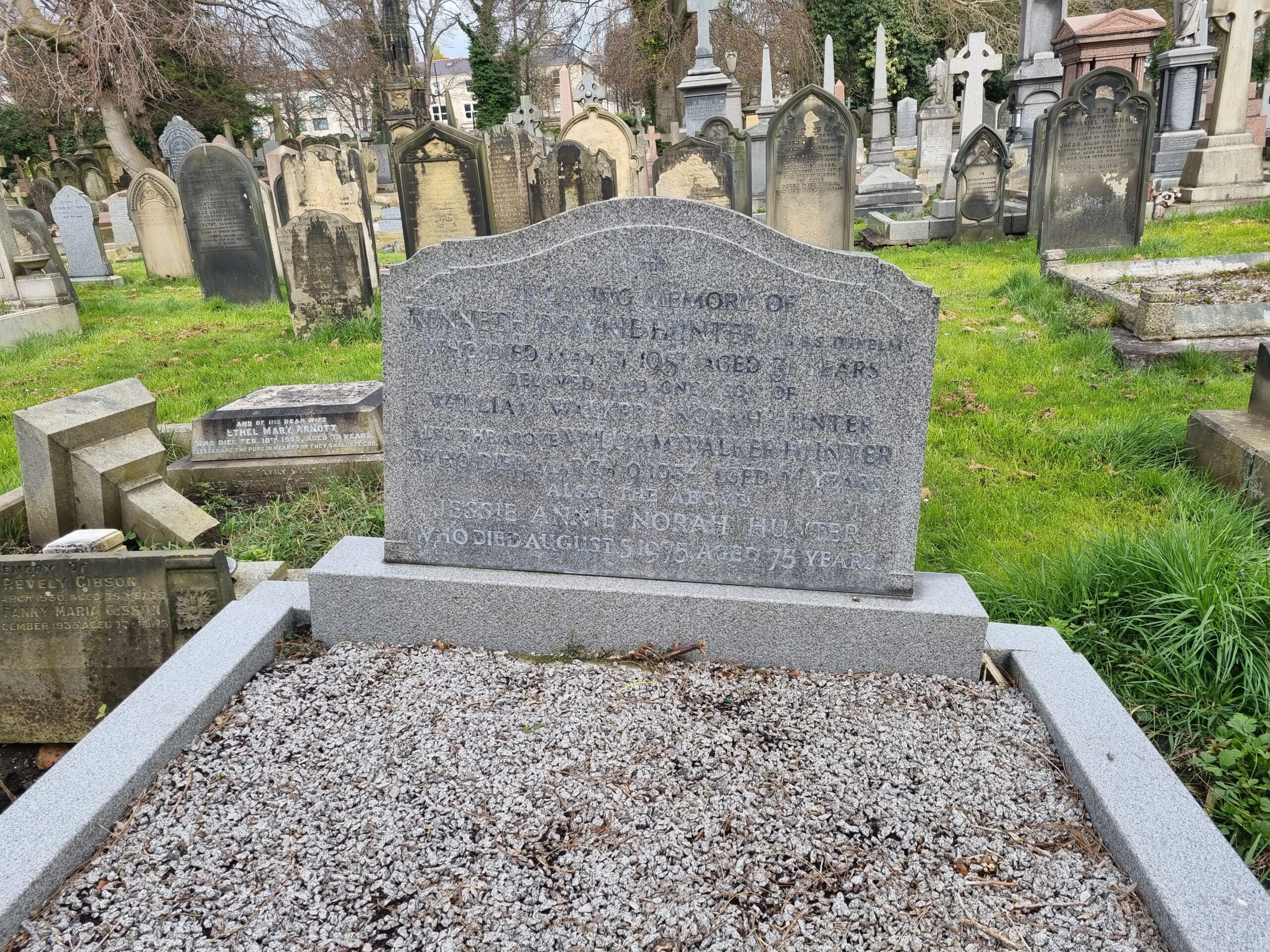
The Hunter Family Grave.
One of the many ‘things’ we love about our work in Jesmond Old Cemetery is the absolute joy of helping to connect the past with the present and, by doing so, preserving whatever transpires via this connection, for the future – a kind of virtuous and vital historical timeline. Our website is a fantastic catalyst for this ‘transaction of information’ and there are many examples of us being contacted by descendants of those buried within Jesmond Old Cemetery, either asking for help or providing us with information. A fantastic recent example of the latter is when the lovely Caroline (Caly) Hunter Milne contacted us via email on the 18th March 2023, telling us, “I think I have a good story for you (what a great way to start an email and catch our attention!!), it concerns my maternal grandfather, William Walker Hunter, who is interred in JOC, alongside his son, parents-in-law, a sister-in-law and my late grandmother, Mrs. J.A.N. Hunter. To get straight to the point, W.W. Hunter was a pharmacist in Barrass Bridge, Newcastle upon Tyne, where his business was in the name of W.W. Owen and Son – my grandfather had bought the pharmacy from Mr. Owen. W.W. Hunter invented the original formula for a health drink, which he named….. Lucozade!! I am pretty sure you will know that name. I would be delighted to come down from Edinburgh to tell you the rest of the story”
Naturally, we were very keen to meet Caly and she duly arrived at the South Lodge a couple of weeks later, with an absolute treasure trove of interesting documents, beautiful photographs and a fascinating story to tell about her family history.
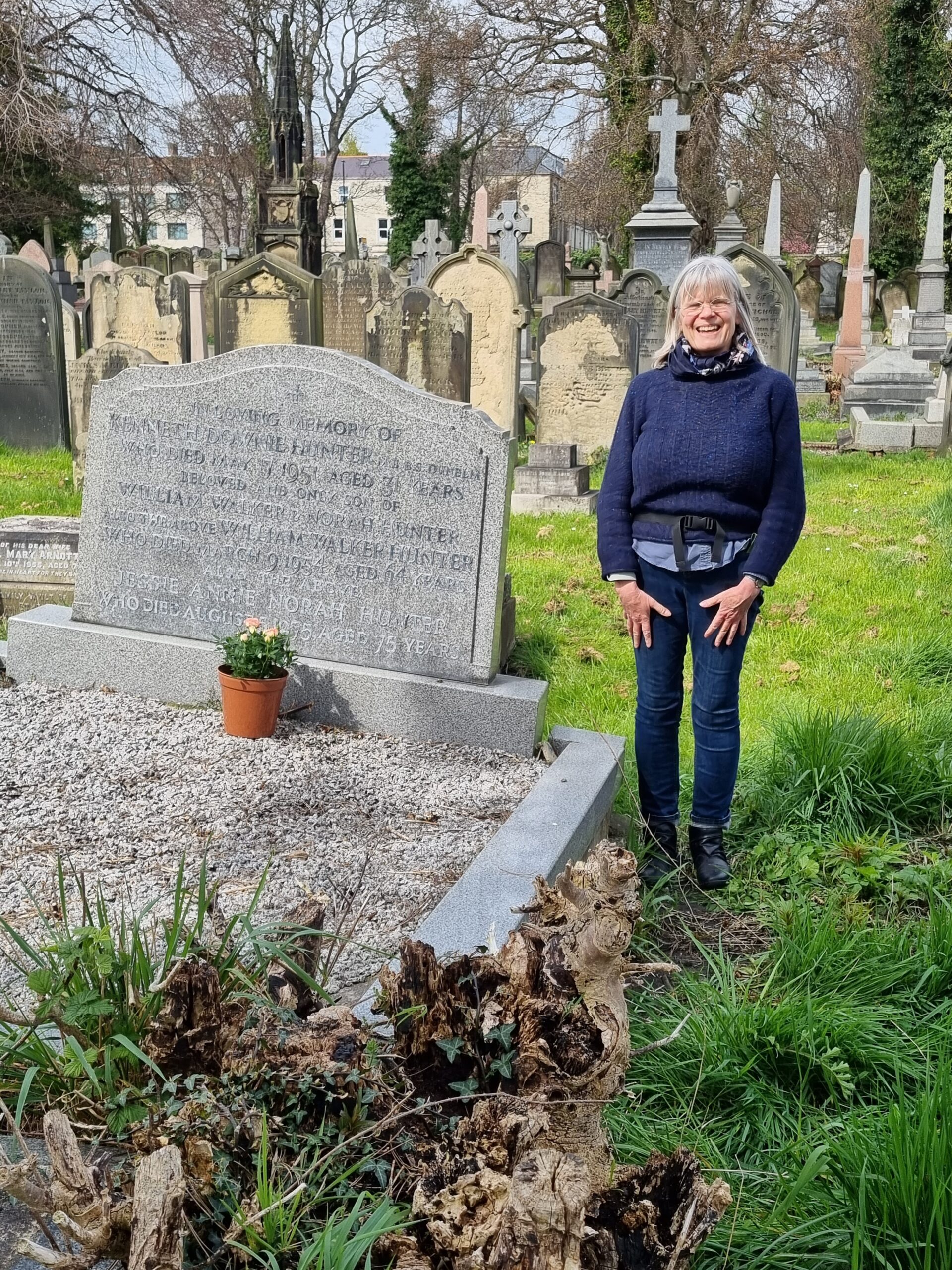
Caly at the family grave on a recent visit to Jesmond Old Cemetery.
So, in terms of the family headstone in Jesmond Old Cemetery, the following information is based on Caly’s recollections and family documents, with a few additional facts provided by the FOJOC.
William Walker Hunter was born in Dunfermline on the 11th July 1889 and was the youngest of eight children born to John Hunter, a coal miner, and Elizabeth, nee Addie. At this moment in time, little is known about his early education and employment history but it is thought that William worked in a pharmacy in St. Andrews, which would have been a major influence on his subsequent career and success. However, prior to his wealth in later years, it can be said that William came from quite a poor background, with him joking to his children that, as a child, a birthday treat for him was to get an extra fish head for his tea!! He was, never the less, determined to do well and William’s family recall that he left Scotland and went “awa doun to England to seek his fortune”

William Walker Hunter in 1952.
In August 1917, William married Jesse Annie Norah Pritchard. Norah, or Nolly as she was known to her family, was one of four children born to Noah (1848 – 1934), a Master Gardener and Elizabeth Pritchard nee Jobson (1850 – 1922), the other three being Amelia (1884 – 1961), who became a Schoolteacher, Isabella/Ella (1888 – 1964), who became a District Nurse/Health Visitor, and Stanley (1893 – 1955), who became an engineer, beginning his career as an apprentice at Wigham Richardson.
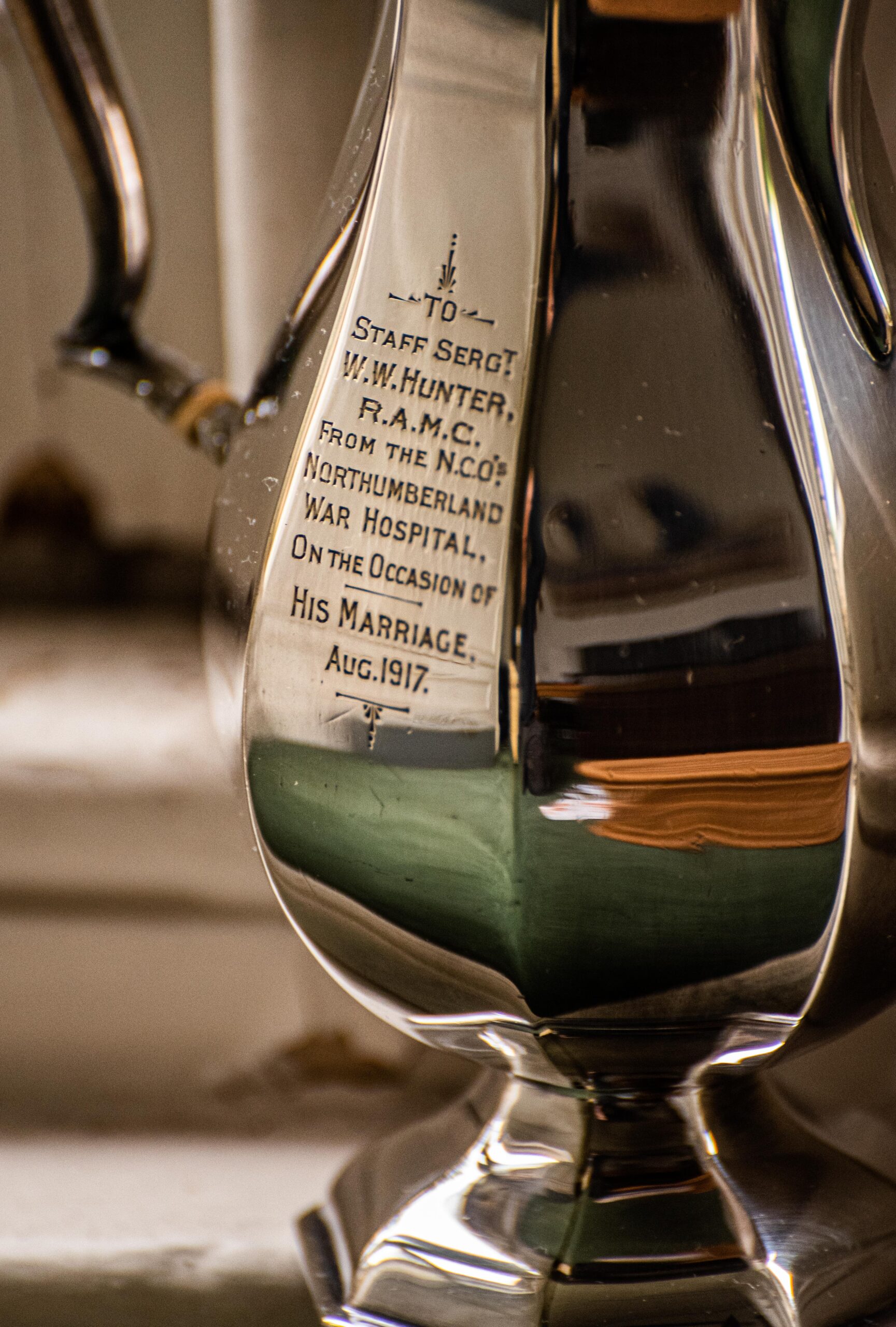
A decorative silver jug, presented to William to celebrate his marriage to Nolly.
Nolly was born on 29th September 1885 in Ellingham, Northumberland, and initially studied at Skerry’s Secretarial College in Newcastle; in the 1911 Census, aged 25, Nolly is recorded as being an ‘Engineering Clerk – Ordnance’ at Armstrong Whitworth; as such, she would have had some ‘business knowledge’, which would have been of some significance to the subsequent success of the Lucozade story. Her family recall that Nolly had certain habits that were certainly from her days of working in business, for example rubber bands being collected and kept around her wrist, and the re-use of envelopes, which included flattening them and using them as bookmarks, for writing lists on and for re-posting, too!!
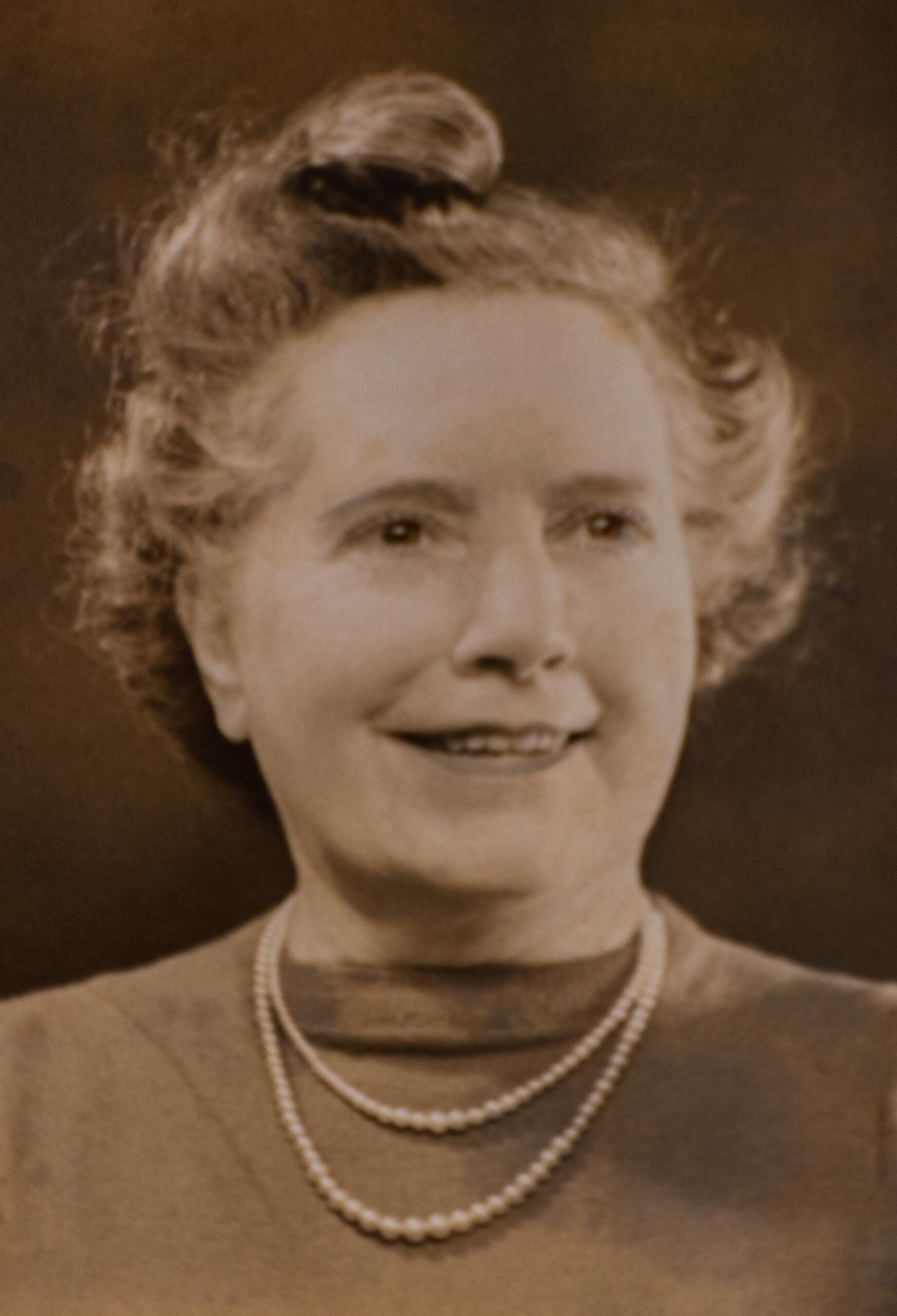
Nolly or Jesse Annie Norah Walker, nee Pritchard.
William and Nolly lived at 61, Holly Avenue, Jesmond and then 11, Montagu Avenue, Gosforth. They had two children, Kenneth Downie Hunter, born on 15th October, 1919, and Elizabeth June Hunter, born on 21st June, 1923.
Kenneth studied at the Royal Grammar School in Newcastle and, after finishing his schooling, he graduated from Durham Medical School in 1942 where, during his undergraduate studies, he was also awarded an Ophthalmology Medal. As medical students were a ‘reserved occupation’ during the war, Kenneth was not called up for military service until after his graduation, where he duly joined the R.A.M.C. as a Captain. After the war, Kenneth went on to be a Pathologist and spent some time working in Tubigen, Germany – a famous University and Medical School. Kenneth was a vibrant character who had a wide range of interests and hobbies, including stamp collecting, reading National Geographic magazine (he was a meticulous planner of touring holidays), building things with his Meccano, photography, listening to music (with Elgar’s Enigma Variation of Nimrod a particular favourite) and playing music – he was an accomplished player of the viola. Kenneth was engaged to be married to Marguerite but, tragically, he died before their wedding could be arranged.
Kenneth died, aged 32, on the 17th May 1951 at Tor-na Dee, Milltimber, Aberdeenshire, from the complications of Pulmonary Tuberculosis. Naturally, this came as a terrible shock for to family and, understandably, his father, William, never really came to terms with the loss of his son.
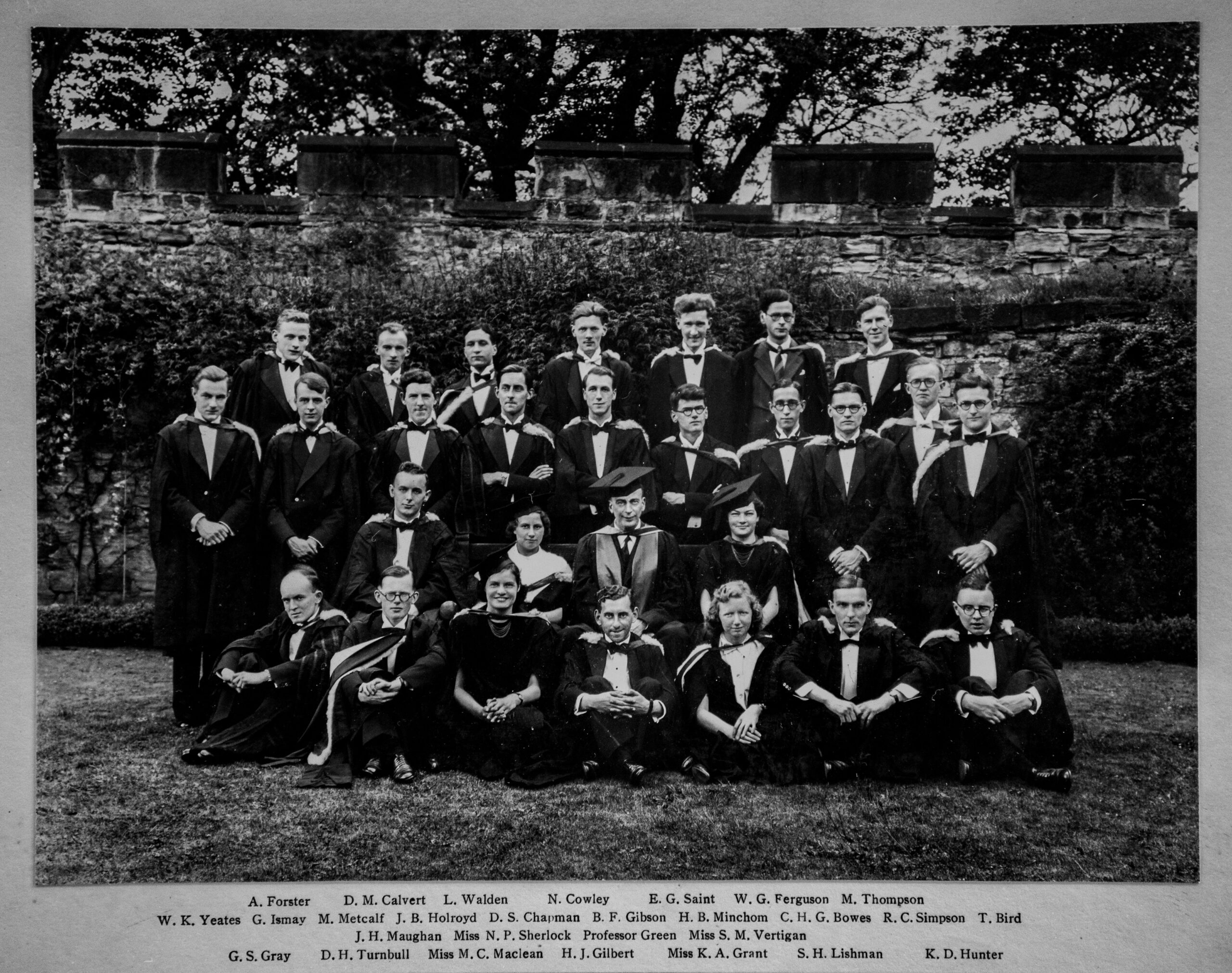
Kenneth Downie Hunter, extreme right in the front row, Medical Year group photograph, Durham University.
William died, aged 64, on 9th March, 1954 in Windsor Nursing Home, Windsor Terrace, Newcastle and Nolly died, aged 89, on 5th August, 1975. Interestingly, Caly tells us that there is an error on the Hunter headstone in Jesmond Old Cemetery as Nolly was not aged 75 when she died; Caly’s mother, Elizabeth June, decided not to have the error corrected as she always told her that her grandmother was always happy to have people think she was a little younger than she actually was, particularly as she was some five years older than William!!
In terms of the Lucozade story, it is ‘accepted wisdom’ that the esteemed surgeon and Emeritus Professor Frederick Charles Pybus (1883 – 1975) – as a sidenote, Pybus worked with Sir Thomas Oliver – was the ‘inventor’ of the glucose based drink, with Pybus explaining his involvement in a note, which now forms part of his collection of papers presented to Newcastle University.
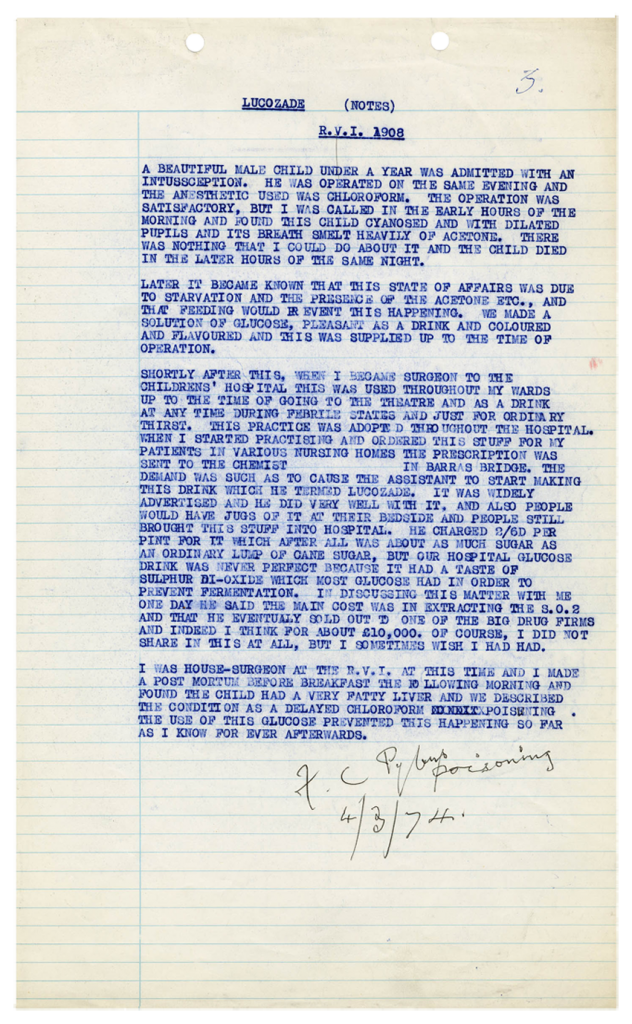
On the University ‘Special Collections’ website, they describe how “during his student days working as a House-Surgeon at the Royal Victoria Infirmary in 1908, he lost a young patient following a seemingly successful operation. It was felt that this was because the child was starved, leading to them not being able to break down the chloroform used as an anaesthetic and resulting in a slow poisoning of the liver. This tragic event clearly affected the young Pybus and when he became a surgeon at the Fleming Memorial for Sick Children following his graduation, he made sure patients drank a glucose drink he devised prior to surgery and when they had a fever to stop this happening again.
An enterprising chemist in Barras Bridge called William Owen provided the ingredients as a prescription, but noticing its popularity, started making it himself and indeed perfected the recipe, with Pybus admitting that his had a taste of sulphur bi-oxide which most glucose had in order to prevent fermentation. Owen called this drink Glucozade, but in 1938, Beecham pharmaceutical company realized the commercial potential and bought the formulae for the then princely sum of about £10,000, and Lucozade was born. Pybus admits in his note that although he had no share in this, I sometimes wish I had.”
Interestingly, a search for Lucozade on Wikipedia tells us that “Lucozade was created as Glucozade in the U.K. in 1927 by a Newcastle pharmacist, William Walker Hunter (trading as W.Owen & Son), it was acquired by the British pharmaceutical company Beecham’s in 1938 and sold as Lucozade, an energy drink for the sick.”
A ’supplementary’ account to the above is provided by Mr. H.G. Lazell who, at his retirement, was Chairman of the Beecham Group, the multi-product giant pre-eminent in pharmaceuticals, foods and proprietary goods. In his autobiography, ‘From Pills to Penicillin – the Beecham Story’, published in 1975 by Heinemann Ltd., Lazell gives a detailed account of his discovery and subsequent purchase of Lucozade from William Walker Hunter, thus;
During our negotiations with Beechams in 1938, John Gibson, one of our travellers, told me about a Mr. Hunter, the owner of a chemist business named W. Owen & Son, of Newcastle. Newcastle was a substantial medical centre and Owen & Son, being near the Newcastle Infirmary (R.V.I.), filled many prescriptions from the consulting physicians of that area. At that time, jaundice was prevalent and the doctors were prescribing glucose – ‘mixed with fruit juices to taste’. People were coming back to Hunter’s shop, complaining that their invalid could not keep the glucose down, no matter what they mixed with it. Then Hunter’s own daughter was taken ill with the complaint. Hunter had equipment to carbonate water in the basement of his shop and he conceived the idea of producing a carbonated drink containing as much glucose as he could get in, and flavoured with a mixture of lemon and orange oils. In due course, the drink was produced, tried successfully on his daughter and some other customers, and after testing and further experimentation, put on the market as Lucozade.
Our traveller, John Gibson, told us that the business in Lucozade had become too big for Hunter to handle and that he was prepared to sell. I looked at the product and concluded that the cost of freight would make it impossible to sell nationally from the Maclean factory (in London). We were not in the soft-drink business and had no bottling plants spread around. However, Gibson would not be put off and came to see us again with the figures. We looked at these and discovered that if we could achieve nationally the sales already being made in the Newcastle area, we would have a turnover of over £1,000,000 per annum!! I went off to Newcastle post-haste with Mac and Koch, our Consulting Engineer.
Hunter was a Scot who had served through the First World War in the Medical Corps. He and Mac hit it off immediately but clearly he had reservations about Koch and myself but we became good friends afterwards. We spent all day inspecting Hunter’s plant and in negotiating a deal, subject to our Board’s approval. Finally we agreed a selling price of £90,000 with a provision for an additional capital payment related to sales in excess of £100,000 per annum during the first two years. We were to form a separate company and Hunter was to join the Board at a salary.
Years later, I learnt that Sterling Drug, the U.S. company, refused to allow their British subsidiary, Scott & Turner Ltd., makers of Andrews Liver Salt (also in Newcastle), to purchase Lucozade. What they missed! For a time after the war, , Lucozade was providing about one-third of the U.K. profits of Beecham Group – its importance to Beechams in the decade 1951 – 61 cannot be exaggerated.”
So….. a few gaps in the Lucozade story just now and some areas requiring further clarification. Caly and her family are busy scrutinizing their family archives in an effort to bridge those gaps and to provide some clarification, particularly in terms of the ‘path of invention’ for the Lucozade formulae, from Pybus to Hunter, via Owen, including when and how William Hunter acquired the business from Mr. Owen. Like all family stories, we may never know all the facts as private thoughts and public discretion, differing interpretations of events and the inevitable fading of memories during the mists of time, all bear influence on the ‘facts’. Never the less, a fascinating tale to hear and tell, with more to come from Caly and her family – we’ll update this page when we have more information and insight to share.